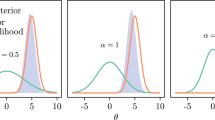Abstract
In the last decade several authors discussed the so-called minimum trace factor analysis (MTFA), which provides the greatest lower bound (g.l.b.) to reliability. However, the MTFA fails to be scale free. In this paper we propose to solve the scale problem by maximization of the g.l.b. as the function of weights. Closely related to the primal problem of the g.l.b. maximization is the dual problem. We investigate the primal and dual problems utilizing convex analysis techniques. The asymptotic distribution of the maximal g.l.b. is obtained provided the population covariance matrix satisfies sone uniqueness and regularity assumptions. Finally we outline computational algorithms and consider numerical examples.
Similar content being viewed by others
Reference notes
Hakim, M., Lochard, E. O., Olivier, J. P. & Térouanne, E.Sur les traces de Spearman. Cahiers du bureau universitaire du recherche opérationelle, Université Pierre et Marie Curie, Paris, 1976.
Della Riccia, G. & Shapiro, A.Minimum rank and minimum trace of covariance matrices. Department of Mathematics, Ben-Gurion University of the Negev, Beer Sheva, Israel, 1980.
Moss, A. G.Theoretical aspects of weight-vector maximization of composite test reliability. Institute of Educational Technology, The Open University, Walton Hall, England, 1977.
References
Bentler, P. M. Alpha-maximized factor analysis (alphamax): its relation to alpha and canonical factor analysis.Psychometrika, 1968,33, 335–345.
Bentler, P. M. A lower-bound method for the dimension-free measurement of internal consistency.Social Science Research, 1972,1, 343–357.
Bentler, P. M. & Woodward, J. A. Inequalities among lower bounds to reliability: with applications to test construction and factor analysis.Psychometrika, 1980,45, 249–267.
Bertsekas, D. P. & Mitler, S. K. Steepest descent for optimization problems with nondifferentiable cost functions.Prceedings of the 5th Annual Princeton Conference on Information Sciences and Systems, 1971.
Bellman, R.Introduction to matrix analysis. McGraw-Hill, 1960.
Cullum, J., Donath, W. E. & Wolfe, P. The minimization of certain nondifferentiable sums of eigenvalues of symmetric matrices.Mathematical Programming Study 3, North-Holland Publishing Company, 1975.
Dem'yanow, V. F. & Malozemov, V. N.Introduction to minimax. Wiley, New York, 1974.
Guttman, L. Best possible systematic estimates of communalities.Psychometrika, 1956,21, 273–285.
Guttman, L. To what extent can communalities reduce rank?Psychometrika, 1958,23, 297–307.
Gantmacher, F. R.The theory of matrices. New York, 1959.
Gilbert, E. An iterative procedure for computing the minimum of a quadratic form on a convex set.SIAM Journal Control, 1966,4, 61–80.
Goldstein, A. A. Optimization of Lipshitz continuous functions.Mathematical Programming, 1977,13, 14–22.
Harman, H.Modern factor analysis. Chicago, 1976.
Jackson, P. H. & Agunwamba, C. C. Lower bounds for the reliability of the total score on a test composed of non-homogeneous items: I: Algebraic lower bounds.Psychometrika, 1977,42, 567–578.
Ledermann, W. On a problem concerning matrices with variable diagonal elements.Proceedings of the Royal Society Edinburgh, 1939,60, 1–17.
Madsen, K. & Schijoer-Jacobson. Linearly constrained minimax optimization.Mathematical Programming, 1978,17, 208–223.
Pshenichnyi, B. N.Necessary conditions for an extremum. Marcel Dekker, Inc., New York, 1971.
Rockafellar, R. T.Convex analysis. Princeton, 1970.
Stein, F. M.Singular integrals and differentiability properties of functions. Princeton Mathematics Serial no. 30, 1970.
Shapiro, A. Rank-reducibility of a symmetric matrix and sampling theory of minimum trace factor analysis.In press.
Ten Berge, J. M. F., Snijders, T. A. B., & Zegers, F. E. Computational aspects of the greatest lower bound to the reliability and constrained minimum trace factor analysis.Psychometrika, 1981,46, 201–213.
Woodhouse, B. & Jackson, P. H. Lower bounds for the reliability of the total score on a test composed of nonhomogeneous items: a search procedure to locate the greatest lower bound.Psychometrika, 1977,42, 579–591.
Zangwill, W. J.Nonlinear programming, a unified approach. Prentice-Hall, 1967.
Author information
Authors and Affiliations
Additional information
I wish to express my gratitude to Dr. A. Melkman for the idea of theorem 3.3.
Rights and permissions
About this article
Cite this article
Shapiro, A. Weighted minimum trace factor analysis. Psychometrika 47, 243–264 (1982). https://doi.org/10.1007/BF02294158
Received:
Revised:
Issue Date:
DOI: https://doi.org/10.1007/BF02294158




